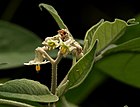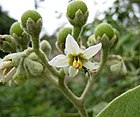Note: This is a project under development. The articles on this wiki are just being initiated and broadly incomplete. You can Help creating new pages.
Solanum erianthum
Big eggplant is an unarmed shrub or small tree usually growing up to 4 metres tall, with occasional specimens to 10 metres. The stem is up to 20 cm in diameter. The plant is cultivated in some areas for its fruits, which are used in curries. This plant is belongs to Solanaceae family.
Contents
[hide]- 1 Uses
- 2 Parts Used
- 3 Chemical Composition
- 4 Common names
- 5 Properties
- 6 Habit
- 7 Identification
- 8 List of Ayurvedic medicine in which the herb is used
- 9 Where to get the saplings
- 10 Mode of Propagation
- 11 How to plant/cultivate
- 12 Commonly seen growing in areas
- 13 Photo Gallery
- 14 References
- 15 External Links
Uses
Leucorrhoea, Vertigo, Piles, Haemorrhoids, Scrofula, Headache, Headache, Dysentery, Diarrhoea, Fever, Arthritis.[1]
Parts Used
Chemical Composition
It contains the major components of the leaf oil were the hydrocarbon monoterpenes: α terpinolene (17.8%), α-phellandrene (17.5%), p-cymene (15.7%) and β-pinene [2]
Common names
| Language | Common name |
|---|---|
| Kannada | Choudangi, Kaadusunde, Arimanigida |
| Hindi | |
| Malayalam | |
| Tamil | Anaichundai |
| Telugu | Rasagadi |
| Marathi | |
| Gujarathi | |
| Punjabi | |
| Kashmiri | |
| Sanskrit | Gandhira, Pathi |
| English |
Properties
Reference: Dravya - Substance, Rasa - Taste, Guna - Qualities, Veerya - Potency, Vipaka - Post-digesion effect, Karma - Pharmacological activity, Prabhava - Therepeutics.
Dravya
Rasa
Guna
Veerya
Vipaka
Karma
Prabhava
Habit
Identification
Leaf
| Kind | Shape | Feature |
|---|---|---|
Flower
| Type | Size | Color and composition | Stamen | More information |
|---|---|---|---|---|
| {{{5}}} |
Fruit
| Type | Size | Mass | Appearance | Seeds | More information |
|---|---|---|---|---|---|
Other features
List of Ayurvedic medicine in which the herb is used
Where to get the saplings
Mode of Propagation
How to plant/cultivate
Found at elevations from 300 - 2,100 metres in the tropics of Asia.[5]
Commonly seen growing in areas
Slightly shaded places, In brushwood, On roadsides, In field edges, On waste ground.
Photo Gallery
References
- Jump up ↑ Indian Medicinal Plants by C.P.Khare
- Jump up ↑ Chemical constituents
- Jump up ↑ Karnataka Aushadhiya Sasyagalu By Dr.Maagadi R Gurudeva, Page no:139
- Jump up ↑ [Morphology]
- Jump up ↑ Cultivation
External Links
- Ayurvedic Herbs known to be helpful to treat Leucorrhoea
- Ayurvedic Herbs known to be helpful to treat Vertigo
- Ayurvedic Herbs known to be helpful to treat Piles
- Ayurvedic Herbs known to be helpful to treat Haemorrhoids
- Ayurvedic Herbs known to be helpful to treat Scrofula
- Ayurvedic Herbs known to be helpful to treat Headache
- Ayurvedic Herbs known to be helpful to treat Dysentery
- Ayurvedic Herbs known to be helpful to treat Diarrhoea
- Ayurvedic Herbs known to be helpful to treat Fever
- Ayurvedic Herbs known to be helpful to treat Arthritis
- Herbs with Fruits used in medicine
- Herbs with common name in Kannada
- Herbs with common name in Tamil
- Herbs with common name in Telugu
- Herbs with common name in Sanskrit
- Habit - Shrub
- Index of Plants which can be propagated by Seeds
- Herbs that are commonly seen in the region of Slightly shaded places
- Herbs that are commonly seen in the region of In brushwood
- Herbs that are commonly seen in the region of On roadsides
- Herbs that are commonly seen in the region of In field edges
- Herbs that are commonly seen in the region of On waste ground
- Herbs





